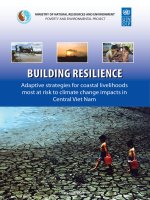Climate change adaption in VN
Bạn đang xem bản rút gọn của tài liệu. Xem và tải ngay bản đầy đủ của tài liệu tại đây (6.74 MB, 80 trang )
Workshop on
AAAAAAAAAAAAAAAA
CLIMATE CHANGE ADAPTION
IN VIETNAM
Tran Hong Thai,
Deputy Director, Vietnam Institute of Meteorology, Hydrology and Environment
New Zealand, December 2013
CONTENTS
1)
Climate Change in Viet Nam
2)
Climate Change Scenarios
3)
Vietnam Response to Climate Change
CURRENT STATUS OF
CLIMATE CHANGE IN VIETNAM
Most likely and serious Impacts
3,000 km
coast line
Sea level
rises as
the key
impact
4
WB report - Problem from CC in Viet Nam
Sea level rises 20 cm in the last 50 years
500 dead per year
US$ 1.5 billion (1,5% of annual GDP)
80% farmers living in rural areas with agriculture
livelihood
Threats for millennium objectives, sustainable
development and poverty reduction
The poor suffer twice
Vietnam is the second biggest rice exporter
5
Mean temperature
Temperature
Rainfall
Lạnh hơn
Ấm hơn
°C/thập kỷ
Trend of mean annual
temperature
Over the past 50 years,
annual average temperature
has increased 0.5oC.
Winter temp increased
faster than summer temp.
Temp in the North
increased faster than in the
South.
Temp inland increased
faster than in coastal areas
and islands.
Rainfall
Rainfall
drier
wetter
%/thập kỷ
• Dry season: slight change in
the North, but increasing
strongly in South;
• Rainy season: decreases ~ 510% in the North, increase ~
5-20% in the South;
• Annual mean: increase in the
South, decreases in the North;
• Rainfall in rainy season in
Central VN increases stronger
than
others,
up
to
~20%/50years;
Change in rainfall (%) over 50 past years
Trend of maximum and minimum daily
Temperature
Tn trend
Tx trend
24N
Tx
NE
22N
24N
NW
deg.C/decade
ND
20N
Tn
NE
22N
0.55
NC
NW
20N
0.35
0.55
NC
0.45
18N
deg.C/decade
ND
0.45
0.35
18N
0.25
0.25
0.15
16N
0.15
16N
0.05
0.05
SC
14N
−0.05
CH
SC
14N
−0.15
−0.25
12N
−0.05
CH
−0.15
−0.25
12N
−0.35
−0.35
−0.45
10N
8N
102E
S
104E
106E
−0.45
10N
S
−0.55
108E
110E
112E
8N
102E
104E
106E
−0.55
108E
110E
112E
• Minimum temperature has increased more than maximum
temperature, particularly over NW, south of NC, SC and CH
Extreme rainfall amount
RX1day trend
RX5day trend
24N
NE
NE
22N
NW
%/decade
ND
20N
11
NC
NW
20N
7
11
NC
9
18N
%/decade
ND
9
7
18N
5
3
16N
5
3
16N
1
SC
14N
−1
CH
1
SC
14N
−5
12N
−1
CH
−3
−3
−5
12N
−7
−9
10N
8N
102E
S
104E
106E
−7
−9
10N
S
−11
108E
110E
112E
8N
102E
104E
106E
−11
108E
110E
Khô hơn
22N
Ẩm ướt hơn
24N
112E
RX1day: annual maximum 1-day rainfall (mm)
RX5day: annual maximum consecutive 5-day rainfall (mm)
• Have not change significantly for NW, NE, NC, and most stations of S.
• Significantly decrease at some stations in ND by up to 11%/decade
• Significantly increase at most stations in SC and CH
Typhoon
• Slight increase in east
sea, but change in
frequency of typhoon
landing Vietnam is not
clear;
• Landing area of typhoon
retreated southward;;
• frequency of very strong typhoon
(> level 12) increases;
• Typhoon season withdraw tends
to be lately;
•
Drought
Drought occure more requently,
especially extreme levels
Dry and deficient water was
significantly in dry season of 20102011. Water level, discharge, and water
reserves in water reservoir have
minimum levels.
Flood
Red River: Annual flow has decreased in recent years, but
strong flood events occure more requently.
Mekong River: Sequence of strong flood occurred in
2000, 2001 and 2002, crest of flood at Tan Chau is over
4,5m indicate that there is increase of hydrological
extremes.
More and more flash flood is serious, number of serious
flash flood in period:
• 1970 - 1980: 7;
• 1981 - 1990: 8;
• 1991 - 2000: 103;
• 2001 - 2013: 183.
20
18
Số lần xuất hiện
16
14
12
10
8
6
4
2
0
History Floods
Lao Cai 2012
Đập Khe Mơ – Hà Tĩnh
Quảng Ngãi 11/2010
Others extreme Climatic Events, Disaster
• Drizzling rain decreases
significantly;
• Cold front decreases;
• Cold days, damaging cold
days decrease, but appeared
extremes cold spell;
• Heat wave increases in central
and southern areas;
• Off-season extreme rainfall
events occure more requently;
• ENSO has stronger effects on
weather and climate in Viet
Nam
Climate Change Scenarios
for Viet Nam
Climate Change Scenarios
Emission Scenarios
Models Applied
• Statistical Downscaling:
• Low emission scenario (B1);
• Medium emission scenario (B2) SDSM, SimClim
• High emission scenario (A2,
• Dynamic Downscaling:
A1FI)
AGCM/MRI, PRECIS
Baseline: 1980-1999
GHG emission scenario (IPCC)
Climate Change Scenarios
•
•
•
•
Temperature in Winter: XII-II
• Yearly Average Temperature
Temperature in Spring: III-V
• Extreme Temperature in Winter
Temperature in Summer: VI-VII • Extreme Temperature in Summer
Temperature in Autumn: IX-XI
• Annual Extreme Temperature
Number of Days with Temperature > 35oC
Mức tăng nhiệt độ mùa đông
kịch bản phát thải thấp
Mức tăng nhiệt độ mùa đông
kịch bản phát thải trung bình
Mức tăng nhiệt độ mùa đông
kịch bản phát thải cao
Climate Change Scenarios
•
•
•
•
Rainfall in Winter: XII-II
Rainfall in Spring: III-V
Rainfall in Summer: VI-VII
Rainfall in Autumn: IX-XI
(a)
(b)
• Annual Rainfall
• Maximum Daily Rainfall
(c)
Sea Level Rise Scenarios
• Low emission scenario (B1): 49-64cm.
• Average emission scenario (B2): 57-73cm.
• High emission scenario (A1FI): 78-95cm.
Inundation Map
(Sea Level Rise 1m)
Area: 20.876 Km2 (6,3%)
If sea level rise 1 m:
• 39% area of Mekong Delta, over 10%
area of Red River Delta, over 2,5% of
coastal area of the Central, over 20%
area of Ho Chi Minh city will be
inundated.
• 35% population of Mekong Delta, over
9% population of Red River delta,
about 9% population of the Central,
7% population of HCM City are
directly affected.
• 4% of the railway system, 9% of
national highways, 12% of provincial
highways unaffected.
Red River Delta
Tỉnh
Q Ninh
Ha Noi
Ha Nam
Hai Phong
Hung Yen
Hai Duong
Bac Ninh
Ninh Binh
Thai Binh
Nam Dinh
Vinh Phuc
%
11.3
0.3
6.0
17.4
3.3
7.2
1.6
10.2
31.2
24.4
0.0
TP HỒ CHÍ MINH
20.1 %
Mekong Delta
39%
AnGiang
BacLieu
BenTre
CaMau
CanTho
DongThap
VinhLong
TraVinh
SocTrang
TienGiang
LongAn
KienGiang
HauGiang
2.2%
45.7%
33.3%
55.9%
19.0%
4.8%
15.6%
27.8%
51.2%
30.3%
28.5%
74.8%
79.4%
Case study of
Kiên Giang and Cà Mau
Approach
The study area includes 2
provinces: Kiên Giang and
Cà Mau, it is a part of Cuu
Long Delta.
To assess impacts of
Climate change on Water
resources of the two
provinces it is necessary to
assess the impacts on the
whole Cuu Long Delta.
The boundaries are: from
Kratie and Great lake to
the sea.
Kratie









